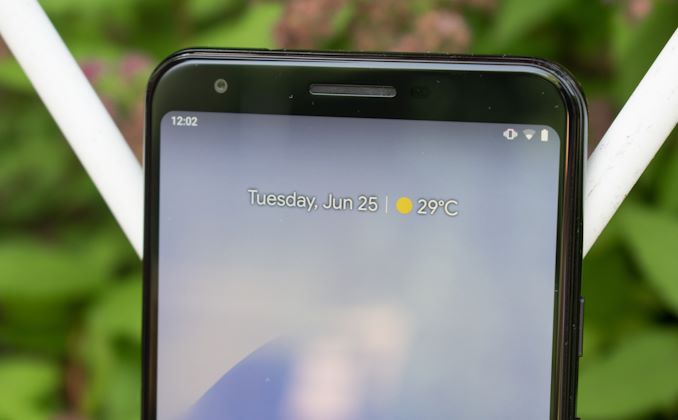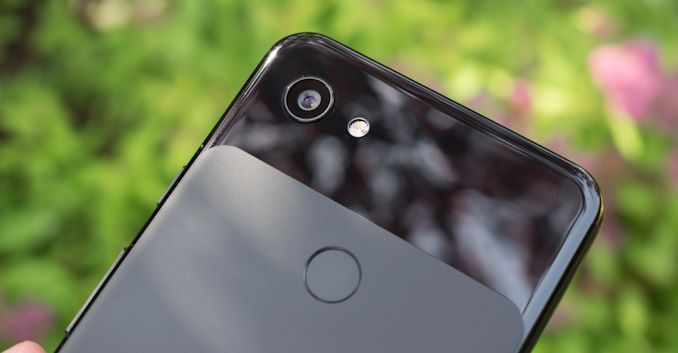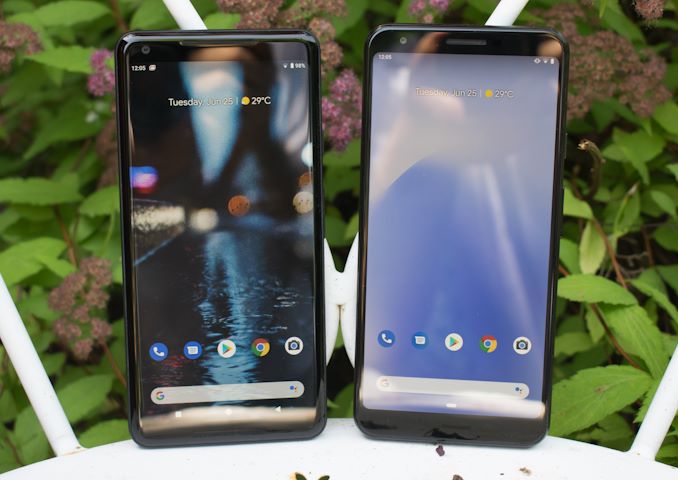The Google Pixel 3a XL Review: Does Mid-Range Make Sense?
by Andrei Frumusanu on June 27, 2019 8:00 AM EST- Posted in
- Mobile
- Smartphones
- Snapdragon 670
- Pixel 3a
- Pixel 3a XL
Conclusion & End Remarks
We don’t review mid- and lower-end devices nearly as often as we’d like to here, but the Pixel 3a was an interesting device to have put through the mill.
In terms of design, there’s nothing really exciting about the Pixel 3a XL. Google opted to keep it safe, avoiding any notch or fancier screen design, and simply went for the larger top and bottom bezels on the front of the phone. Whilst this isn’t a terrible design choice, it’s to be noted you can get a lot more modern looking phones from the competition.
Google’s choice of plastic on the 3a works quite well- it’s a high grade polycarbonate and the matte part of the back cover really feels more premium than what you’d expect. There’s still some concern in terms of durability; the phone will be significantly more prone to scratches than a metal or glass phone, and I don’t expect the top glossy part of the phone to age that well with usage. The bonus here of course is that there’s no risk of breaking the back panel if you do happen to drop it.
In terms of performance, everyday usage and CPU bound tasks perform very well thanks to the Snapdragon 670. The chipset performs at around the level of a Snapdragon 835, which while isn’t the best experience by now, it’s still extremely respectable.
Google’s choice of going with eMMC isn’t quite a dramatic as one would think, thanks to the filesystem optimisations and relatively good quality NAND, there’s only limited scenarios where the downgrade is noticeable. Still, yes it’s a tad slower on application installations, however I do find it as a reasonable compromise.
The display on the Pixel 3a XL is good: Opting to go OLED in this price-range is still an excellent choice as there’s still a lot of vendors opting to go the LCD route. Whilst it’s evident that Google tried to calibrate the display, they did so incorrectly, and the phone ends up with a messed up gamma curve that spoils an otherwise good calibration, with the end result ending up as just “ok”.
Thanks to the larger 3700mAh battery and the high efficiency of the Snapdragon 670 as well as no obvious issues on the part of the display panel, battery life on the 3a XL is excellent and falls in line with S845 generation flagship phones of similar battery capacity. The key here is that the 3a XL does a lot better than the regular Pixel 3 and Pixel 2 XL due to not having the bad LG display panels.
The camera on the Pixel 3a is supposed to be the hallmark feature of the phones as it sports the very same camera sensor on as on the Pixel 3 line-up. The camera results between the two phones are indeed near identical and this comes with all the advantages as well as disadvantages.
In daylight, the Pixel 3a still doesn’t produce very realistic exposures as Google’s processing always prioritises on maintaining the brightest highlights of a scene at the cost of much reduced dynamic range in the shadows. Many times there’s also an evident lack of any levels beyond 90%, and the aforementioned exaggerated blacks. In many shots it’s possible to fix this after-the-fact, but in some shots there’s just too little dynamic range.
Details on the Pixel cameras remains amongst the very best even when compared to the latest flagships. Here Google’s lack of any degrading daytime noise reduction is able to correctly preserve details and textures, and I have no idea why other vendors keep failing in this regard.
Low-light photography thanks to Night Sight is among the best out there. The mode has been bested now by Huawei and Samsung, however in the mid-range class of devices the Pixel 3a should very much hold significant advantages.
Speakers on the Pixel 3a XL are good – it’s not the best, but the fact that the phone even has stereo is something that’s a differentiating factor against mono competitors. Having the 3.5mm headphone jack is also pleasant and useful, even though it’s a bit ironic that we have to use the cheaper Pixel models to have this feature.
Value Verdict: North Amercia
Overall, the verdict on the Pixel 3a and Pixel 3a XL should be based on the value proposition that the phone offers. In order to come to any conclusion here we need to investigate what the options are.
For users in the North America, things are relatively straightforward. Due to a lack of options and restrictive market, the Pixel 3a seem like very good choices given their price of $399 for the regular and $479 for the XL.
The real only competition the 3a would have here is if you manage to get a previous generation flagship at a reduced cost. For example a new Pixel 2 XL can still be found for cheaper than the 3a XL at the time of writing. Also if you’re into it, there’s a large amount of other older flagship devices one could buy and simply slap on Google’s camera APK- ironically invalidating most of the advantages that come with buying a Pixel phone.
Still, getting a new phone such as the 3a with guaranteed future software updates and the many exclusive North American Google ecosystem features makes sense and I can see the value in that.
Rest of World
For users in the rest of the world, I don’t think the Pixel 3a phones are competitive.The phone’s sole advantage here lie in the software experience that is sometime more streamlined than what most Asian OEMs besides Samsung are able to offer.
For example a Xiaomi Mi9 with the Snapdragon 855, more competent triple-camera setup, an under-screen fingerprint scanner, and a flagship design currently costs only 394€ in Europe which is actually cheaper than the 486€ price tag of the Pixel 3a XL. There’s a ton more options from other vendors such as Xiaomi, Huawei, Honor and even some mid-range series from Samsung that overall make so much more sense in terms of value.
Unfortunately I fear Google will have very little success with the Pixel 3a outside of North America, and if you're amongst those regions there’s very little reason to get the new phone if you’re aiming to maximise the bang-for-buck.













94 Comments
View All Comments
RSAUser - Thursday, June 27, 2019 - link
/looks at phone without a screen protector that's over 2 years old without any scratchesWhat are you talking about? Depends on the person.
Oyeve - Thursday, June 27, 2019 - link
And most people are idiots who don't care about sound quality. Thats why there are so many bitch-buds on the market. For those of us who actually own very good headphones we all know blue headphones are garbage. We want loud high quality sound and BT does not come even close. I use a Fiio amp and good wired headphone on all of my phone because BT sucks.grant3 - Thursday, June 27, 2019 - link
The idea that plastic is "more prone to dents & scratches" than aluminum is laughable.The idea that plastic is "less durable" than glass is laughble.
Yet this author is happy to make such a claim with literally no experience let alone proof to support his assertion.
fred666 - Friday, June 28, 2019 - link
plastic is the superior choice because it is light, lets the magnetic waves through and absorbs (some of) the shock instead of breaking like glass or transmitting it to the components like metal.MadManMark - Monday, July 1, 2019 - link
I know, I consider the plastic a feature, not a compromise!deskjob - Thursday, June 27, 2019 - link
I must be an unicorn. I stopped using a case with the OG pixel. Haven't looked back. Maybe I am more careful or less clumsy when it comes to gadgets. I've dropped it once from about 4ft onto sidewalk, fortunately only got minor chip around one corner. Otherwise the no scratches anywhere. So yeah that info matters to me.Also headphone jack is one of the main reasons I am even considering the 3a XL. True, most people don't care because they don't care about sound quality in general. That's cool. There are still some people out there who do care about sound quality. I use a bluetooth speaker for podcasts, but wired for anything else.
nucc1 - Sunday, June 30, 2019 - link
You get the case for that once or twice a year drop just like you. This way, you're far less likely to need repairs and it's more freedom from worrying about your phone.Without a case, the phone can start looking really worn out after a year and it might make you replace it sooner than you have to.
MadManMark - Monday, July 1, 2019 - link
You're not alone. If people like to spend $1000 on a phone and then wrap it up in quasi-bubble wrap to make it chunky, that's fine. I like to buy phones for just a few hundred (due to their trade-in program this one cost me $210 net, after I bought an iPhone 6 to trade in) and then just USE it. I put on a screen protector, but as far as a case: if there is a scratch on the plastic back, there is a scratch. It doesn't affecgt anything, and I'll be upgrading in a few years again anway. Who is always looking at the BACK of their phones in the first place?grant3 - Friday, July 5, 2019 - link
I think the screen on the 3a xl is probably stronger than the body.I bought a case for mine because i drop it a lot, but for the last few years people have been starting to convince me the screen protector is not really needed.
melgross - Thursday, June 27, 2019 - link
Very high quality polycarbonate? I’ve done extensive work in materials; wood, metal and plastic. I’ve used numerous brands of polycarbonate. They are all the same.The differences between utilization is what you’re noticing. Differing thicknesses, differing tapering of the thickness over the sheet used in the body. Differing curves, giving different impressions as to strength and resistance to indentation from pressure, etc.
The different textures also leave thoughts as to quality. But the plastic is all the same. Pretty much exactly so.
One of the benefits is that there should be no dents due to banging the device, which is the opposite to what you have with the necessarily thin metal used, which is strong, but a dent magnet, in many designs, particularly in cheaper devices. Polycarbonate, while like every other plastic, is soft, in fact, it’s noticeably softer than the otherwise much more easily broken acrylic. Both can have anti scratch coating applied, but that substantially increases the cost, and isn’t used with textured finishes. Besides, it wears off on devices that are constantly being fondled by their owners.